By Eric Vandenbroeck and co-workers
An Authentic Description of Palestine
The most celebrated and reliable
chronicler of pre-Zionist Palestine. was Mark Twain, who wrote about his
travels in the Holy Land in The Innocents Abroad in 1869.
It is Twain’s literary genius that gives us the most
indelible images of the wasteland that was Palestine: Palestine sits
in sackcloth and ashes. Over it broods the spell of a curse that has withered
its fields and fettered its energies. Where Sodom and Gomorrah reared their
domes and towers, that solemn sea now floods the plain, in whose bitter waters
no living thing exists, over whose waveless surface the blistering air hangs
motionless and dead, about whose borders nothing grows but weeds, and scattering
tufts of cane, and that treacherous fruit that promises refreshment to parching
lips, but turns to ashes at the touch. Nazareth is forlorn; about that ford of
Jordan where the hosts of Israel entered a solitude that is inhabited only by
birds of prey and skulking foxes. Palestine is desolate and unlovely. And why
should it be otherwise? Can the curse of the Deity beautify a land? Palestine
is no more of this work-day world. It is sacred to poetry and tradition, it is
dream-land.1
In Jezreel, Twain
recounted the Bible’s Song of Deborah and Barak, and then added: “Stirring
scenes like these occur in this valley no more. There is not a solitary village
throughout its whole extent, not for thirty miles in either direction. There
are two or three small clusters of Bedouin tents, but not a single permanent
habitation. One may ride ten miles, hereabouts, and not see ten human beings.”
2 Twain found the Sea of Galilee and its surrounding areas no less desolate:

It is solitude, for
birds and squirrels on the shore and fishes in the water are all the creatures
that are near to make it otherwise. Still, it is not the sort of solitude to
make one dreary. Come to Galilee for that. If these unpeopled deserts, these rusty
mounds of barrenness, that never, never, never do shake the glare from their
harsh outlines, and fade and faint into vague perspective; that melancholy ruin
of Capernaum; this stupid village of Tiberias, slumbering under its six
funereal plumes of palms; yonder desolate declivity where the swine of the
miracle ran down into the sea, and doubtless thought it was better to swallow a
devil or two and get drowned into the bargain than have to live longer in such
a place; this cloudless, blistering sky; this solemn, sailless,
tintless lake, reposing within its rim of yellow hills and low, steep banks,
and looking just as expressionless and unpoetical (when we leave its sublime
history out of the question,) as any metropolitan reservoir in Christendom, if
these things are not food for rock me to sleep, mother, none exist, I think.3
[That is, the area was exceedingly tranquil.]
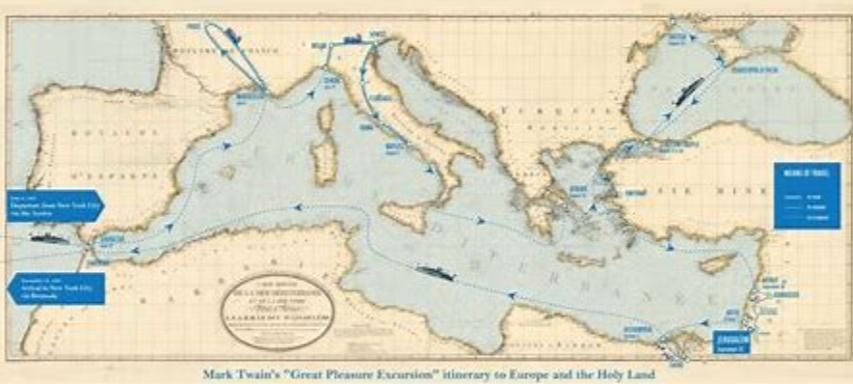
Sir John William
Dawson stated the obvious in 1888 when he said: “No nation has been able to
establish itself as a nation in Palestine up to this day. No national union and
no national spirit has prevailed there. The various impoverished tribes which
have occupied it have held it as mere tenants at will, temporary landowners,
evidently waiting for those entitled to the permanent possession of the soil.”
4
The wait would not be
much longer. An English clergyman, Reverend Samuel Manning, described the Plain
of Sharon as “a land without inhabitants” that “might support an immense
population.” 5
British Christian Zionists
The desolate land was
catching the attention of Christian politicians in nineteenth-century Britain.
They began expressing the idea that it would be in the best interests of the
Jews and the world if the Jews returned to Palestine and reclaimed it as their
homeland. In 1838, Lord Lindsay published the first edition of his Letters on
Egypt, Edom, and the Holy Land after traveling through Palestine. He opined
that “it is possible that, in the changes of the Turkish empire, Palestine may
again become a civilized country, under Greek or Latin influences; that the
Jewish race, so wonderfully preserved, may yet have another stage of national
existence opened to them; that they may once more obtain possession of their
native land, and invest it with interest greater than it could have under any
other circumstances.” 6
Lindsay characterized
the absence of the land’s actual indigenous people to be its chief drawback:
Many, I believe, entertain the idea that a real curse rests on the soil of
Palestine and maybe startled, therefore, at the testimony I have borne to its
actual richness. No other curse, I conceive, rests upon it, then that induced
by the removal of the ancient inhabitants, and the will of the Almighty that
the modern occupants should never be so numerous as to invalidate the prophecy
that the land should enjoy her Sabbaths so long as the rightful heirs remain in
the area of their enemies…. [T]he land still enjoys her Sabbaths, and only
waits the return of her banished children. The application of industry
commensurate with her agricultural capabilities, to burst once more into
universal luxuriance, and be all that she ever was in the days of Solomon.7

Anthony Ashley
Cooper, seventh earl of Shaftesbury, a member of Parliament and a devout
Christian, was of much the same mind. On July 24, 1838, he wrote that he was
“anxious about the hopes and destinies of the Jewish people:”
Everything seems ripe
for their return to Palestine; ‘the way of the kings of the East is prepared.’
Could the five Powers of the West be induced to guarantee the security of life
and possessions to the Hebrew race, they would now flow back in rapidly augmenting
numbers. The inherent vitality of the Hebrew race reasserts itself with
incredible persistence; its genius, to tell the truth, adapts itself more or
less all over the world, nevertheless always emerging with distinctive features
and a gallant recovery of vigor. There is an unbroken identity of Jewish ideas
down to our times: but the great revival can take place only in the Holy Land.8

Shaftesbury was
determined not just to talk about this but to act upon it: “By the blessing of
God I will prepare a document, fortify it by all the evidence I can accumulate,
and, confiding to the wisdom and mercy of the Almighty, lay it before the Secretary
of State for Foreign Affairs.” 9
Shaftesbury went to
Lord Palmerston, who was the secretary of state for foreign affairs at the time
and laid the proposal before him. He recorded Palmerston’s measured reaction in
his diary:
August 1st, 1838. -
Dined with Palmerston. After dinner left alone with him. Propounded my scheme,
which seemed to strike his fancy, he asked some questions and readily promised
to consider it. How singular is the order of Providence! Unique, that is if estimated
by man’s ways! Palmerston had already been chosen by God to be an instrument of
good to His ancient people, to do homage, as it were, to their inheritance, and
to recognize their rights without believing their destiny. And it seems he will
yet do more. But though the motive is kind, it is not sound. I am forced to
argue politically, financially, commercially; these considerations strike him
home; he weeps not like his Master over Jerusalem, nor prays that now, at last,
she may put on her beautiful garments.10

Meanwhile,
Shaftesbury continued to spread the idea that Jews should return to Palestine.
He read Lindsay’s work and was impressed. In a January 1839 magazine article,
he gave Letters on Egypt, Edom, and the Holy Land an enthusiastic review and
proposed making Lindsay’s hope a reality by resettling the Jews in Palestine
under British rule or at least military protection. This would, he argued, be
in the best interests of Britain itself: The soil and climate of Palestine are
singularly adapted to the growth of produce required for the exigencies of
Great Britain; the finest cotton may be obtained in almost unlimited abundance;
silk and madder are the staples of the country, and olive oil is now, as it
ever was, the very fatness of the land. Capital and skill are alone required:
the presence of a British officer, and the increased security of property which
his presence will confer, may invite them from these islands to the cultivation
of Palestine; and the Jews, who will betake themselves to agriculture in no other
land, having found, in the English consul, a mediator between their people and
the Pacha, will probably return in yet more significant numbers, and become
once more the husbandmen of Judaea and Galilee.11
It was Lord
Shaftesbury who coined the apposite phrase
“A land without people, for a people without a land.” 12
In 1840, his meeting
with the foreign secretary bore fruit: Palmerston offered the British government’s protection to
Jews in Palestine and even communicated to the Ottoman sultan his opinion that
it would benefit the Ottoman Empire if “the Jews who are scattered throughout
other countries in Europe and Africa should be induced to go and settle in
Palestine.” The sultan did not respond favorably, and Zionism remained a
concern primarily of the British. Lieutenant-Colonel George Gawler, who
had served as the British governor of Australia, issued this call in 1845:
“Replenish the farms and fields of Palestine with the energetic people whose
warmest affection are rooted in the soil.” In 1852, Gawler founded
the Association for Promoting Jewish Settlement in Palestine.13
The Zionist idea was
not forgotten in nineteenth-century Britain. It would continue to be considered
at the highest levels of the British government, along with, paradoxically,
schemes that would challenge Zionism at its core.
The Ottomans attempted to stop the
Zionist movement altogether by banning Jewish immigration to its domains. The
British were concerned. On November 19, 1891, the interim British ambassador to
the Ottoman Empire, Sir William Arthur White, wrote to British Prime Minister
Robert Gascoyne-Cecil, third marquess of Salisbury, confirming that the prime
minister had instructed him to ask the Sublime Porte for “further explanations
concerning the recent prohibition against Jewish immigrants entering the
Ottoman Empire.” 14
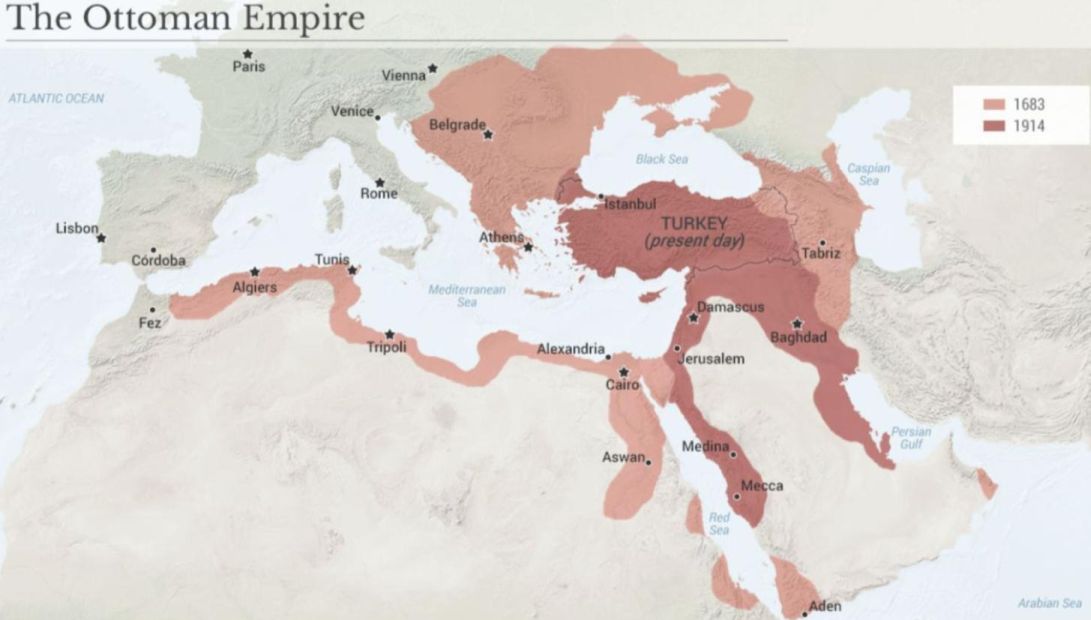
Nonetheless, those immigrants kept coming. After the
outbreak of World War I, taking into account all the support for Zionism among
highly placed Britons and reasoning that they would fare better if Palestine
were under British rule rather than that of the Ottomans, many Jews in
Palestine aided the British in numerous ways. The Ottomans responded with a
campaign of mass deportations of Jews. In 1917, Ottoman officials rounded up
the seven thousand Jews who were living in Jaffa and sent them north on a brutal
forced march out of Palestine.15 This was not an isolated incident. By the end
of the war, the Jewish population of Palestine had been reduced from its prewar
total of ninety thousand to fewer than sixty thousand.16
Nevertheless, as they
had throughout history, Jews continued to come to the land. The British Royal
Commission stated accurately in 1937 that “always…since the fall of the Jewish
state, some Jews have been living in Palestine. Fresh immigrants arrived from
time and time…[and] settled mainly in Galilee, in numerous villages spreading
northwards to the Lebanon and in the towns of Safad and Tiberias.” 17
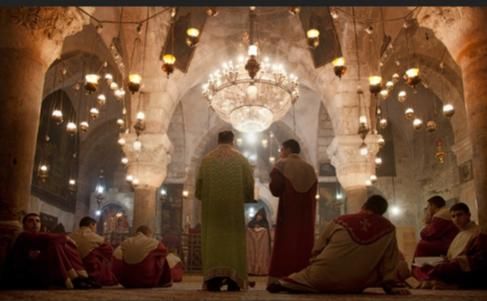
The Muslim Arab Influx
Arabs began to come
as well, although their presence in the land remained generally sparse. In
1830, Muhammad Ali of Egypt conquered Jaffa, Nablus, and Beisan and settled Egyptian and Sudanese Muslim Arab
soldiers there. Around the same time, the French conquest of Algeria led to an
exodus of North African Muslims who refused to live under infidel rule. They
came in large numbers to Palestine. Once there, they followed the pattern of
the Turks and other Arab Muslims in making life as difficult as they possibly
could for the Jews. “They constitute,” noted another English clergyman, the
Reverend W. M. Christie, who lived in Haifa in the early twentieth century,
“the most fanatical section of the Palestine population.” 18
In a glimpse of what was to come,
Christie added: “To a great extent without education, they are ready to accept
any statement concerning things done to the detriment of Islam, and to act
without a sense of responsibility. In 1889, we often heard it remarked that the
10,000 Moslems living in a state of barbarism in the Mughrabi Quarterwere a real danger to the city. In the recent
massacres [of Jews] in Safed, it was this party that carried through the
nefarious work.” 19

These North African
Muslims were not singular. Many, if not most, of the Arabs in Palestine were
not the descendants of those who had conquered the land in the seventh century.
Most of them had arrived from elsewhere. In 1930, Christie published a study entitled
“Arabs and Jews in Palestine.” He noted “the settlement of sections of Yemenite
and Kaisite Arabs in Nazareth and Cana of
Galilee,” as well as “representatives of the Muslim rulers settled in the
larger towns, Jerusalem, Hebron, Nablus, Jenin, Nazareth, and Acre. These are
probably represented today by the Effendi class, who claim, without
genealogical proof, however, to be the descendants of the conquerors.” 20
Apparently, most
present-day Palestinians arrived from elsewhere.
Muslims came from
far-off lands. According to Christie, when the great twelfth-century jihad
warrior Saladin “was hard-pressed by the Crusaders, he begged help from Persia,
and in response, there came 150,000 Persian Moslems, who ultimately received
for services rendered lands in Upper Galilee and the Sidon district.” 21
Christie added:
“Other Arabic-speaking settlers have come from various places outside of
Palestine proper.” 22 He explained that these included Christians, Christians,
who were brought into the area in the latter half of the nineteenth century
from Lebanon and many other places, “and the only soldering element is their
common Arabic speech.” 23 In Galilee, he said, “we meet with Maronites and
Druses, both clearly immigrants,” adding that the Shi’ite Muslims of that
region had a “non-Galilean origin.” 24 Christie concluded: “There remains the
‘Arab’ peasantry or villagers. Every evidence points to their being Arabs only
in the matter of language. They have much less Arabic blood than any of the
sections of the people already named…” 25
In 1938, the
historian William B. Ziff wrote: At the turn of the [twentieth] century, there
were 40,000 Jews in Palestine and about 140,000 others of all complexions. The
inhabitants had no other feeling for this pauperized, disease-ridden country
than a fervent desire to get away from it. Emigration proceeded steadily.
Immigration was virtually non-existent. Not until the Zionists had arrived in
numbers did the Arab population begin to augment itself. The introduction of
European standards of wage and life acted like a magnet on the entire Near
East. Abruptly Palestine became an Arab center of attraction. By 1922, after a
quarter-century of Jewish colonization, their numbers mushroomed to 488,000.
Today they are over a million.
It is precisely in
the vicinity of these Jewish villages that Arab development is most marked.
Arab Haifa, profiting by the Zionist boom, grew from 1922 to 1936 by 130%,
Jaffa by 80%, and Jerusalem by 55%. The rural Arab settlement in the Tel Aviv
district increased by over 135%. The all-Arab city of Nablus, which held 33,000
before the war, has fallen to less than 12,000. Safed, which had 20,000,
dropped to less than 9,000. 26
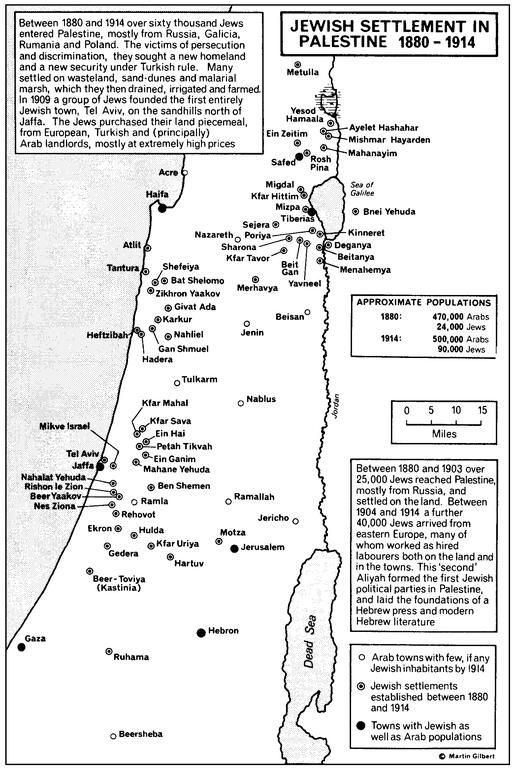
Winston Churchill
observed drily in 1939 when Arab Muslims were ever more frequently presenting
the British with claims of having been victimized by the Jews, that “far from
being persecuted, the Arabs have crowded into the country.” 27
Thus the recent myth
of a stable and settled Palestinian-Arab-Muslim population that had lived in
villages and worked the land for centuries, only to be displaced by the Zionist
invaders, appears to be inconsistent with the recorded demographic data gathered
not by the Jews or Zionists but rather by the local authorities themselves. J.
L. Burkhardt reported that as early as in the second decade of the nineteenth
century, “Few individuals . . . die in the same village in which they were
born. Families are continually moving from one place to another . . . in a few
years . . . they fly to some other place, where they have heard that their
brethren are better treated.” 28
Some Muslims had been
attracted to the new areas of Jewish settlement by the jobs made available by
Jewish immigration and the cultivation of land. A study of the Jewish
settlement of Rishon L’Tzion, first established
in 1882, showed that the 40 Jewish families that settled there had attracted
“more than 400 Arab families,” many of which were Bedouin and Egyptian. These
families moved into areas around the Jewish settlement and formed a new Arab village
on the site of “a forsaken ruin.” 29 The report observed a similar pattern in
Arab-Muslims-Palestinians' other settlements and villages.
Although it is
impossible to reconstruct with any confidence the precise number of
Arabs-Muslims-Palestinians who had lived for generations in what eventually
became the Jewish area under the partition, the number is far below that
claimed by Palestinian polemicists. According to one historian, “at least 25%
of [the Muslims who lived in all of Palestine in 1882] were
newcomers or descendants of those who arrived after [the
Egyptian conquest of 1831].” 30 In addition to the Egyptian influx, there
was considerable immigration of Turks, Greeks, and Algerians.

Moreover, many of the
Palestinian Muslims who were attracted to western Palestine between 1882 and
1893 came from eastern Palestine (the West and East Banks of the Jordan).
Combining these figures leads to the inescapable conclusion that the number of
Palestinians with deep roots in the areas of Jewish settlement, although
impossible to estimate with confidence, constitutes a tiny fraction of the more
than a million Palestinian Arabs who now live in Israel.
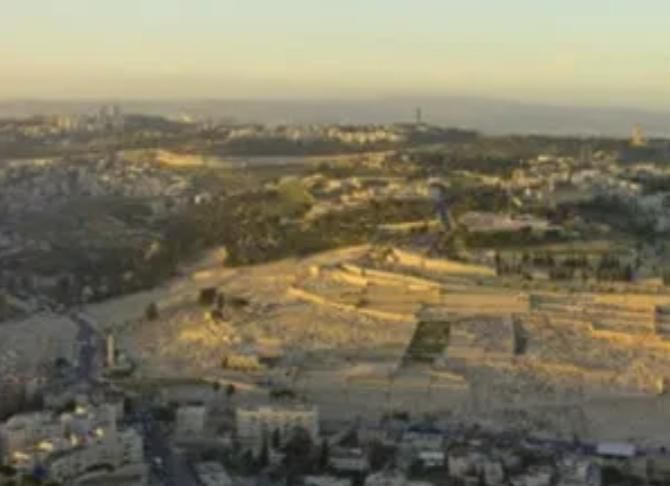
The number of Muslims
who lived in the Jewish areas grew dramatically after the Jewish
settlements blossomed not only because many Arabs were attracted to the newly
settled areas and newly cultivated land but also because the Jewish presence improved
health care, cut infant mortality, and expanded adult life expectancy.
A British official reported in 1937 that “the growth in [the numbers
of Arab fellahin] had been largely due to the health services
combating malaria, reducing infant death rates, improving water
supply, and sanitation.” 31 These improvements began with modern hospitals and
water and sanitary systems introduced into Palestine by the Jewish refugees
from Europe.
Stolen Land?
Another familiar
theme of pro-Palestinian literature today is that the State of Israel exists on
“stolen land”; stolen, from the indigenous people of Palestine. Yet one can
argue that the land is no more stolen than the Palestinian Arabs are its
indigenous inhabitants. As the Ottoman Empire was in its death throes, the
British government began to look ahead. On November 2, 1917, British foreign
secretary Arthur Balfour issued a momentous statement in a letter to Lord
Lionel Walter Rothschild, the leader of the British Jewish community: His
Majesty’s government view with favor the establishment in Palestine of a
national home for the Jewish people, and will use their best endeavors to
facilitate the achievement of this object, it being clearly understood that
nothing shall be done which may prejudice the civil and religious rights of
existing non-Jewish communities in Palestine, or the rights and political
status enjoyed by Jews in any other country.32
This was a
significant boost for the Zionist project, as it was the first time that a
substantial power has expressed support for it, and Jewish immigration into
Palestine increased. The British, however, we're playing both sides. At the
same time that they committed themselves to the establishment of “a national
home for the Jewish people” in Palestine, they were also encouraging the most
vociferous opponents of the Zionist project, the Arabs. Indeed, no less an
authority than Colonel T. E. Lawrence, the celebrated “Lawrence of Arabia,”
admitted that the very concept of Arab nationalism was a British invention. To
be sure, the Arab Muslims of Palestine had always hated the Jews, but the
Arabs, in general, had hated one another as well. According to Lawrence,
however, “the phrase Arab Movement was invented in Cairo as a common
denominator for all the vague discontents against Turkey which before 1916
existed in the Arab provinces.
In a
non-constitutional country, these naturally took on a revolutionary character,
and it was convenient to pretend to find common ground for all of them.” 33 The
British colonel Richard Meinertzhagen, who
served as head of Britain’s military intelligence in Cairo and later as His
Majesty’s chief political officer for Palestine and Syria, was blunter: “Arab
national feeling is based on our gold and nothing else.” 34 Even worse,
Colonel Lawrence, in the course of building the “Lawrence of Arabia” myth about
himself, propagated, primarily in his massive 1926 book Seven Pillars of
Wisdom, the idea that the Arabs, with a bit of help from Lawrence himself, had
played a decisive role in the defeat of the Turks in World War I, driving them
out of Arabia and ultimately even capturing Damascus, setting the stage for the
fall of the empire itself. Hollywood chimed in on this myth-making with the
1962 blockbuster film Lawrence of Arabia. This myth proved to be
extraordinarily destructive, for, after the Balfour Declaration, it became a
staple of Arab Muslim propaganda that the Arabs had heroically and nobly come
to the aid of the British against the Turks in World War I, and instead of
being rewarded, were cruelly betrayed by the perfidious Albionites, who gave the land that had been promised to
them to the Zionists instead. The reality was far from this. Even Lawrence,
after building his myth, admitted in a rare moment of candor that the help the
Arabs offered to bring down the Ottoman Empire was not at all decisive, but “a
sideshow of a sideshow.” 35 Richard Aldington, whose 1955 book Lawrence of
Arabia: A Biographical Enquiry does much to dispel the myths that Lawrence had
woven, discounts the claim that the Arabs contributed much of anything at all
to the British war effort, saying of its wartime activities: “To claim that
these spasmodic and comparatively trifling efforts had any serious bearing on
the war with Turkey, let alone on the greater war beyond is…absurd.” 36
Indeed, says Aldington, “much of the effort of the
Arab forces…was diverted to hanging around on the outskirts of Medina and to
attacks on that part of the Damascus-Medina railway which was of the least
importance strategically.” 37 Even worse (detailed on this website) was the Arab role in the British victory over the Turks in the Battle of
Megiddo, which
broke Ottoman power toward the end of the war. Aldington says that General
Edmund “Allenby’s great breakthrough in September 1918 provided [the Arabs]
with sitting targets which nobody could miss, and the chance to race
hysterically into towns which they claimed to have captured after the British
had done the real fighting.” 38 The British encouraged the
Arabs in this. The Muslim historian Muhammad Kurd Ali recounts that “whenever
the British Army captured a town or reduced a fortress which was to be given to
the Arabs it would halt until the Arabs would enter, and the capture would be
credited to them.” 39
This was calculated to win Arab hearts and minds, but
it did more than that. It gave impetus to the Arab claims after the war that
the British owed them something while owing the Jews nothing, and that they had
been betrayed and were therefore justified in attacking Jews and resisting
their settlement in Palestine. The British did nothing to counter this
impression; quite the contrary. They continued to play both ends against the
middle. One of the final acts of the dying Ottoman Empire in the early 1920s was
to concede control of the lands that came to be known under British authority
as Palestine and Transjordan to the League of Nations. On July 24, 1922, the
league granted administrative control over these territories to Britain. The
League of Nations Mandate for Palestine paved the way for the Balfour
Declaration’s “national home for the Jewish people” to become a reality.
However, it did so with a significant caveat. The Mandate for Palestine stated
that “the Administration of Palestine, while ensuring that the rights and
position of other sections of the population are not prejudiced, shall
facilitate Jewish immigration under suitable conditions and shall encourage, in
co-operation with the Jewish agency referred to in Article 4, close settlement
by Jews on the land, including State lands and waste lands not required for
public purposes.” 40 However, the same document took away 77 percent of the
land that had been initially intended for this purpose: all of the land east of
the Jordan River. The British government added this significant clause into the
“Mandate for Palestine” document: In the territories lying between the Jordan
and the eastern boundary of Palestine as ultimately determined, the Mandatory
shall be entitled, with the consent of the Council of the League of Nations, to
postpone or withhold application of such provision of this Mandate as he may
consider inapplicable to the existing local conditions.41
The “provision of this Mandate” that the British would
“postpone or withhold application of” was a Jewish settlement in the lands east
of the Jordan. That the Jews were expecting these lands to be included in the
mandate is clear from Ze’ev Jabotinsky’s poem “There are two sides
of the Jordan River—this is ours, and that is also.” 42 Jabotinsky didn’t
originate this idea; he got it from the original extent of the British Mandate,
and its stated purpose. So from whom was the land stolen? Not from the Ottomans,
who had ceded it to the League of Nations. Not from the league, which had
granted administrative powers over it to the British. Not from the British, who
supported the creation of Israel, at least at this point. The only land that
was stolen was from the Jews themselves when the British arbitrarily reduced
the size of the area that was to be opened for the Jewish national home.
But surely the Israeli immigrants displaced the native
Arabs from their land, no? No. The Jews who made aliyah in
the nineteenth and early twentieth centuries didn’t come as armed marauders,
seizing land from its owners by force. They obtained the land in a far more
conventional and prosaic way: they bought it. This is acknowledged even by Al
Jazeera in an article claiming that Israel occupied stolen land: “The [Zionist]
movement, citing the biblical belief that God promised Palestine to the Jews,
began to buy land there and build settlements to strengthen their claim to the
area. At the time, these settlements, built largely on the coastal plain and in
the north of the country, were called ‘Kibbutzim’ and ‘Moshavim.’” 43 A 1930
British government report (which was, incidentally, generally favorable to
restrictions on Jewish settlement in Palestine) noted that the Jews not
infrequently overpaid: “The Jewish authorities have nothing with which to
reproach themselves…. They paid high prices for the land, and in addition, they
paid to certain of the occupants of those lands a considerable amount of money
which they were not legally bound to pay.” 44
Because of the absence of precise census or land
records, no one will ever be able to reconstruct, with absolute certainty, the
very precise demographics of the area eventually assigned to the Jewish state
by the U.N. partition of 1947 at the time the Jewish refugees from Europe began
to arrive there. But it is beyond reasonable dispute, based on census figures,
authoritative reports, eyewitness accounts, and simple arithmetic, that the
myth of displacement by the European Jewish refugees of a large, stable,
long-term Muslim population that had lived in that part of Palestine for
centuries is demonstrably false. Even many Arab intellectuals acknowledge the
mythical nature of this claim. As the Palestinian leader
Musa Alami said in 1948, “The people are in great need of a ‘myth’ to
fill their consciousness and imagination.” 45 King Abdullah of Jordan also
recognized that the story of the Jewish displacement of local Palestinians was
a fictional one, acknowledging that “the Arabs are as prodigal in selling their
land as they are in . . . weeping [about it].” 46
In 1947, the UN voted
for Palestine to be split into separate Jewish and Arab states, with Jerusalem
becoming an international city.
That plan was accepted by Jewish leaders but
rejected by the Arab side and never implemented.
It is also clear that
had there been a referendum on the issue of self-determination and separation,
the residents of the area partitioned by the United Nations for a Jewish state
would have voted overwhelmingly in favor of what the United Nations decreed. In
terms of the division of land, the Jewish state received somewhat more than the
Arabs, but only if one counts fully the Negev Desert, which was deemed
uninhabitable and uncultivatable. If the Negev is excluded or substantially
discounted, the usable land allocated to the Arabs was larger than that
allocated to the Jews. Moreover, much of the land allocated to the Jewish state
was originally swamp and desert land that had been irrigated and made fertile
by Jewish labor and investment. The land allocated to the Arabs was also
contiguous with and proximate to Transjordan, whose population has always been
predominantly Palestinian, although a Hashemite monarchy was imposed on the
population by Great Britain.
The land allocated to
the Jews did not include western Jerusalem, which had a Jewish majority, or
Hebron, two of Judaism’s holiest and most historic cities.
Jerusalem, with a
Jewish population of 100,000, was to be internationalized but cut off from the
Jewish areas. Hebron was to be part of the Arab sector, with no Jewish
presence, despite the fact that Jews had lived there for thousands of years
until Palestinian massacres of Jewish women, children, and old men drove out
the Jewish population in 1929 and again in 1936.

Because the land in
which the Jews were to live was divided into noncontiguous areas and separated
by Arab land, it would be difficult to defend in the face of the threatened
Arab attack. In addition to Jerusalem, Safad was isolated. Even Tel Aviv
could easily be cut off by enemy forces at the narrow waistline of the Jewish
area, which measured approximately 9 miles between the Arab area and the
Mediterranean.
Nevertheless, Israel
quickly accepted the U.N. partition and soon declared statehood. The Arabs
rejected the partition and attacked
the new Jewish state from the air and the ground. What remained of the
proposed Palestinian state after Israel repelled these attacks was quickly
gobbled up by Jordan and Egypt.

Had the Arabs
accepted the U.N. partition, there would have been a large, contiguous
Palestinian state alongside a Jewish state. The two-state solution that is now
the international consensus would have been achieved without bloodshed.
Surely anyone who now
accepts the two-state solution must place the blame for it not being
implemented in 1947 (or even earlier in 1937) on the Arab and Palestinian
leaders who rejected a Palestinian state when it was offered to them. A
Palestinian state, with its capital in Jerusalem, was again offered at Camp
David and Taba in 2000 and again rejected by the Palestinians, who
responded to the offer not by making any counterproposal but by increasing
suicide bombings against Israeli civilians.
1 Mark Twain, The
Innocents Abroad, American Publishing Company, 1869, ch. LVI.
https://www.gutenberg.org/files/3176/3176-h/3176-h.htm
2 Ibid., ch. XLVI.
3 Ibid., ch. XLVIII.
4 Katz, p. 107.
5 Alan Dershowitz,
The Case for Israel, John Wiley & Sons, Inc., 2003, p. 27.
6 Alexander William
Crawford Lindsay, Lord Lindsay, Letters on Egypt, Edom, and the Holy Land,
Henry G. Bohn, fifth edition, 1858, p. xi.
7 Lindsay, p. 251.
8 Nahum Sokolow,
History of Zionism 1600-1918, vol. I. Longmans, Green, and Co., 1919, p. 123.
9 Ibid.
10 Ibid.
11 Anthony Ashley
Cooper, 7th Earl of Shaftesbury, “ART. VII.-Letters on Egypt, Edom, and the
Holy Land. By Lord Lindsay. - London, 2 vols. 8vo., 1838.” The London Quarterly
Review, Vol. LXIII. January-April 1839. P. 105.
12 Nur Masalha,
The Zionist Bible Biblical Precedent, Colonialism and the Erasure of Memory,
Routledge, 2013, p. 83.
13 Paul Richard
Wilkinson, For Zion’s Sake: Christian Zionism and the Role of John Nelson
Darby, Wipf and Stock Publishers, 2008, p. 208.
14 Sir William Arthur
White, letter to Robert Gascoyne-Cecil, Marquess of Salisbury, November 19,
1891.
15 Jonathan Adelman,
The Rise of Israel: A History of a Revolutionary State, Taylor & Francis,
2008, p. 58.
16 Katz, pp. 122–124.
17 Peters, p. 147.
18 W. M. Christie,
“Arabs and Jews in Palestine,” Journal of the Transactions of The Victoria
Institute, vol. LXII, Victoria Institute, 1930, p. 98.
19 Ibid.
20 Ibid., p. 97.
21 Ibid.
22 Ibid.
23 Ibid.
24 Ibid.
25 Ibid., p. 98.
26 William B. Ziff,
The Rape of Palestine, Longmans, Green, and Co., 1938, p. 385.
27
Daniel Grynglas, “Debunking the claim that ‘Palestinians’ are the
indigenous people of Israel,” Jerusalem Post, May 12, 2015.
28 John Lewis
Burckhardt, Travels in Syria and the Holy Land (New York: AMS Press, 1983), p.
299.
29
A. Druyanow, Ketavim Letoldot Hibbat Ziyyon Ve-Yishshuv Erez Yisra’el (Writingson the
history of Hibbat Ziyyon and
the settlement of the land of Israel) (Odessa,Tel Aviv,
1919, 1925, 1932), vol. 3, pp. 66-67
30 Ernst
Frankenstein, Justice for my People (London: Nicholson & Watson, 1943), p.
127.
31 Report by His
Britannic Majesty’s Government to the Council of the League of Nations on the
Administration of Palestine and Trans-Jordan for the Year 1937, Colonial No.
146, pp. 223-224
32 Lord Balfour to Lord Rothschild, 2 November, 1917.
33 The above
mentioned Samuel (Shmuel) Katz, a historian who possessed an encyclopedic
knowledge of the circumstances of Israel’s founding, the Palestine situation
before the advent of Zionism, and related issues writing in Battleground: Facts
and Fantasy in Palestine, Taylor Productions, revised edition 2002, pp. 65–66.
34 Ibid., p. 66.
35 Ibid., pp. 65–66.
36 Ibid., p. 49.
37 Ibid., p. 51.
38 “The ‘Mandate’
Defined Where Jews Are and Are Not Permitted to Settle,” League of Nations
Mandate for Palestine, http://www.mandateforpalestine.org/10-permissions.html.
39 Ibid.
40 Ronn Torossian,
“If the West Bank is ‘Occupied,’ Who Are the Occupiers?,” Algemeiner, July 16, 2012.
41 Zena Tahhan,
“Israel’s settlements: 50 years of land theft, explained,” Al Jazeera, November
21, 2017.
42 John Hope Simpson,
Palestine: Report on Immigration, Land Settlement and Development, His
Majesty’s Stationery Office, 1930.
43 “Immigration to
Israel: The First Aliyah (1882-1903),” Jewish Virtual Library,
https://www.jewishvirtuallibrary.org/the-first-aliyah-1882-1903. 100
“Immigration to Israel: The Second Aliyah (1904-
44 “Immigration to
Israel: The Fourth Aliyah (1924-1929),” Jewish Virtual Library,
https://www.jewishvirtuallibrary.org/the-fourth-aliyah-1924-1929; “Immigration
to Israel: The Fifth Aliyah (1929-1939),” Jewish Virtual Library,
https://www.jewishvirtuallibrary.org/the-fifth-aliyah-1929-1939.
45 Quoted in Peters,
p. 11.
46 King Abdullah of
Jordan, My Memoirs Completed, Harold W. Glidden, trans. (London: Longman,
1978), pp. 88-89.
For updates click hompage here